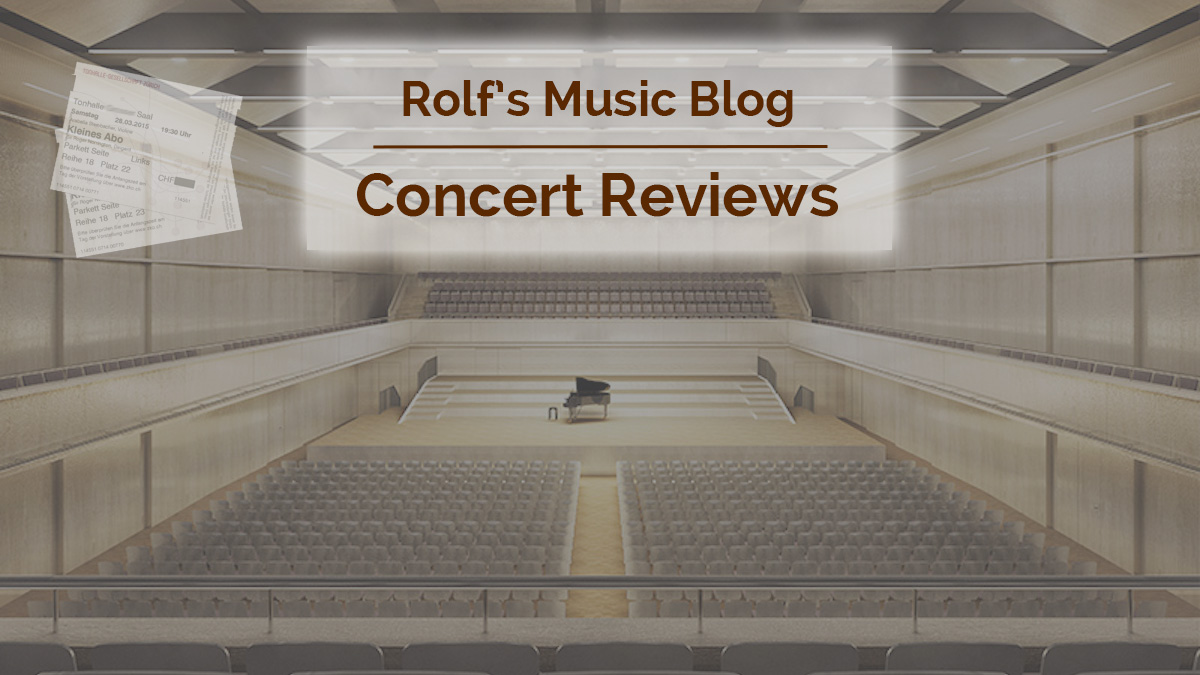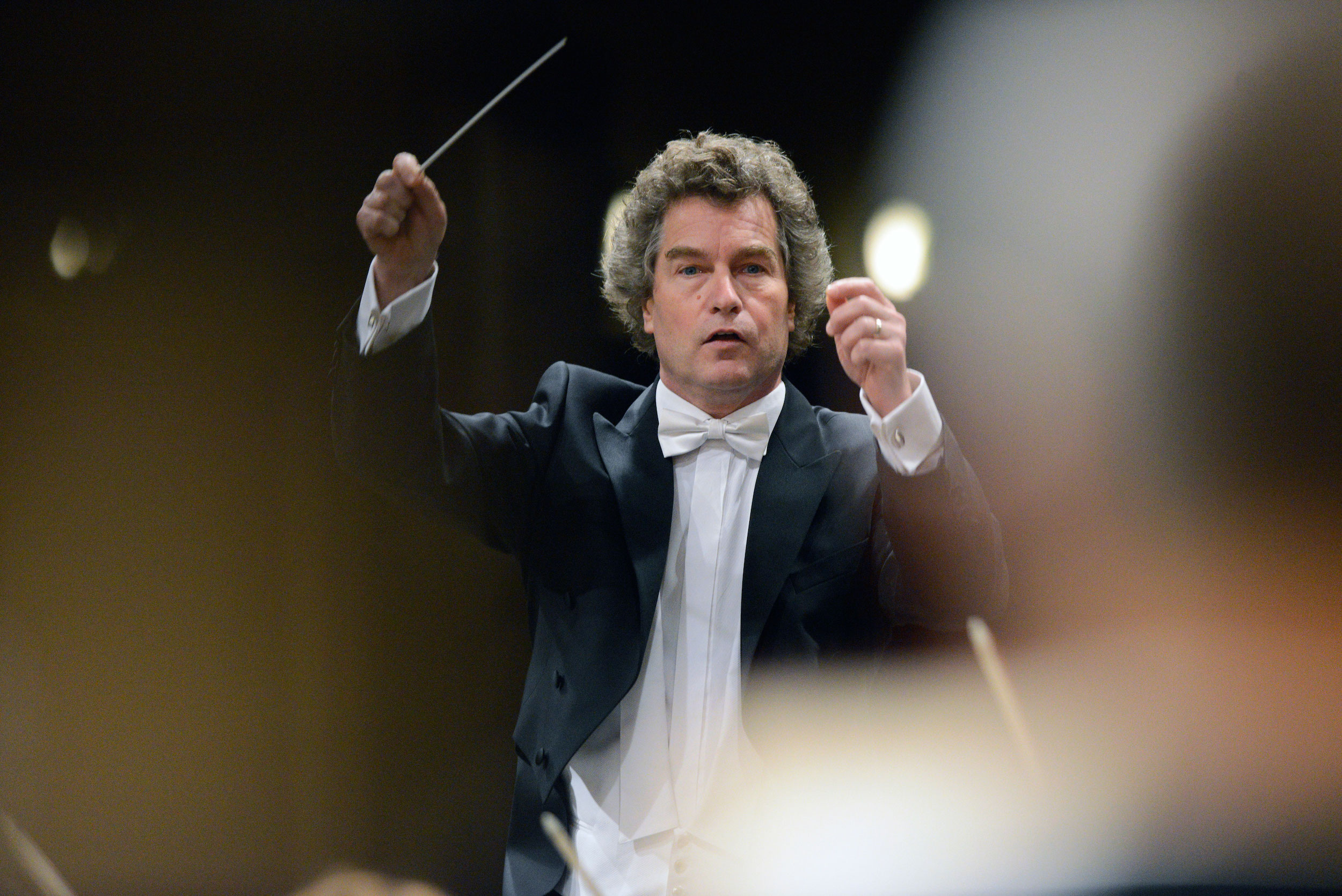Claire Huangci, Heiko Mathias Förster / Prague Royal Philharmonic
Ludwig van Beethoven
Tonhalle Maag, Zurich, 2018-10-20

2018-10-25 — Original posting
Beethoven: theatralisch, konzertant, orchestral — Zusammenfassung
Das 2017 von Heiko Mathias Förster gegründete Prager Philharmonische Orchester präsentierte ein reines Beethoven-Programm:
Die Leonoren-Ouverture Nr.3 präsentierten die Prager in kammermusikalischer Formation. Es zeigte sich bald, dass dieses Format für die Akustik im Saal, wie auch für Beethovens Komposition, ideal war. Förster dirigierte mit klarer Schlagtechnik, das Orchester folgte dem Dirigenten aufmerksam, mit ausgezeichnet balanciertem Klang. Einzig: die Fern-Trompeten hätten die unterschiedlichen Distanzen (d.h., das Näherkommen) differenzierter darstellen können.
Solistin im Klavierkonzert Nr.5 war Claire Huangci, Gewinnerin des Géza Anda-Preises 2018. Sie artikulierte sorgfältig, jederzeit mit ausgewogener Balance von Bass und Diskant, differenziert, ausdrucksvoll, nie mechanisch oder statisch. Trotz Klangfülle (wo gefordert) blieb ihre Darbietung immer fließend, teilweise unterstützt durch große Gesten, weite musikalische Bögen. Das Orchester begleitete sorgfältig, klar und aufmerksam.
In den fünf Sätzen (Szenen!) der Sinfonie Nr.6 erreichte das Orchester einen charaktervollen Streicherklang, differenzierte Dynamik, Phrasierung und Agogik. Es war sehr erfreulich zu hören und zu beobachten, welch hohes Niveau Heiko Mathias Förster mit dem Prager Philharmonischen Orchester innerhalb eines Jahres erreicht hat.
Table of Contents
Introduction
The German conductor Heiko Mathias Förster (*1966, see also Wikipedia) presented a weekend with four “Beethoven Gala” concerts, an afternoon and an evening event on both Saturday and on Sunday. All concerts featured Claire Huangci as soloist and took place in Zurich’s Tonhalle Maag. This was the first of the two on Saturday. The hall (expectedly) was 2/3 full at most. Both Saturday concerts offered the same program, with works by Ludwig van Beethoven (1770 – 1827) exclusively:
- Overture “Leonore” No.3 in C major, op.72b
- Piano Concerto No.5 in E♭ major, op.73, “Emperor”
- Symphony No.6 in F major, op.68, “Pastorale“
The Sunday events featured the Overture to “Fidelio” (see below), Beethoven’s Piano Concerto No.3 in C minor, op.37, and the Symphony No.5 in C minor, op.67.
The Artists
Conductor, Orchestra
This was my third concert encounter with the German conductor Heiko Mathias Förster (*1966, see also Wikipedia). I have previously heard him on 2015-02-15 (with the Staatskapelle Halle) and on 2018-07-02 (with the Zürcher Symphoniker), both concerts also took place in Zurich. In these cases, Förster was guest conductor. This time, he conducted the Prague Royal Philharmonic. That’s an orchestra he founded himself in 2017, in reference to the historic Royal Court Orchestra of Emperor Rudolph II (1552 – 1612) in Prague.
Soloist: Claire Huangci
The soloist for the Beethoven concerto in the center of the program was the American pianist Claire Huangci (*1990, see also Wikipedia). Claire Huangci was born in Rochester, NY. Her parents, both scientists, were Chinese immigrants. Claire Huangci started playing the piano at age 6. She did her main studies at the Curtis Institute, thereafter, 2007 – 2016, continuing her studies at the Hochschule für Musik, Theater und Medien Hannover, with Arie Vardi (*1930). In 2009, she won the first prize at the IX. European Chopin Competition in Darmstadt, as well as the Orpheum Music Prize in Zurich. In 2010, she followed up on these successes, by winning the First and Special Prize at the National Chopin Competition in Miami, USA, and 2011 the Second Prize at the ARD International Music Competition.
In 2018 she had her most recent competition success, when she won the Concours Géza Anda in Zurich. That last success very likely will have a pivotal role in her career, as it comes with a large number of concert opportunities—among them this one and its “evening repeat”, as well as the two on the following day (see above). Another concert, a solo recital, will follow in exactly one month’s time, also here in Zurich—stay tuned!
Beethoven: Overture “Leonore” No.3 in C major, op.72b
Beethoven’s Opera “Fidelio”, op.72, has a somewhat convoluted history. Its first version (1805) already ran under the title “Fidelio”. But then, Beethoven changed that to “Leonore, oder Der Triumph der ehelichen Liebe” (Leonore, or The Triumph of Marital Love). The final version of the opera (now again “Fidelio”) premiered in 1814. Overall, there are now four overtures associated with this opera, see also Wikipedia:
- The 1805 premiere of the first version of the opera is believed to have started with what is now known as Overture “Leonore” No.2, op.72a;
- For the performances of 1806, Beethoven created a larger version (the biggest of the four), now running under the name Overture “Leonore” No.3, op.72b. This is now often performed between the two scenes of the second act of the opera.
- For a planned performance of “Leonore” in 1808, Beethoven cut back op.72b, creating a version, now known as Overture “Leonore” No.1, op.138. This version was apparently never played in Beethoven’s lifetime. It was published after his death.
- In 1814, Beethoven completely reworked the opera, now giving it its final name “Fidelio”, op.72, with a new overture—the “proper” Overture to “Fidelio”.
The Performance
From its size, the ensemble presented itself as a chamber orchestra, rather than a full-size symphony orchestra, with 8 + 8 violins (left), 6 violas (right), 5 cellos, 4 double basses (far right edge). It turns out that this is an excellent ensemble size for the acoustics of this venue. And it’s also an excellent orchestra size for Beethoven’s music.
Heiko Mathias Förster consequently conducted with very clear beating technique, and very accurately. In the Adagio introduction, he consequently built up tension, but did not lose the pace, kept the fermata minimal. The Allegro felt very natural, the dynamics were controlled, careful. Throughout the overture, the orchestra was very attentive, the discipline excellent: the advantage of a newly / recently founded orchestra. It seemed that the orchestra was fresh enough for every musician to pay full attention, to stay alert. I also noted the excellent acoustic balance within the orchestra, in particular, the fitting, appropriate volume of the double basses, and the excellent relation between strings and wind instruments.
Soft Playing?
One quibble: I found that the “distant trumpet” could have been more remote at both distances (the score is not specific, but the first call is usually “far away”, the second one “closer”). Those were the relations here—but both seemed too direct, too close for the intended theater effect. In general, I noted that p (e.g., after the first ff in the Allegro part) and the pp (e.g., in the center of the piece) could typically have been less, softer, more daring (see below for more comments on this). The advantage of the analytical acoustics of this venue is in the transparency, and in the excellent support for the finest, most subtle pp(p).
Rating: ★★★½
Beethoven: Piano Concerto No.5 in E♭ major, op.73, “Emperor”
This is the third concert review featuring the Piano Concerto No.5 in E♭ major, op.73, “Emperor”, by Ludwig van Beethoven (1770 – 1827). Rather than giving a detailed description of the work, let me just refer to two concert performances in Zurich that I have reviewed in this blog. In these blog posts (from concerts on 2016-01-26 and on 2016-12-07), I have given some additional information.
- Allegro (4/4)
- Adagio un poco mosso (4/4)
- Rondo: Allegro ma non troppo (6/8)
The Performance
For the piano concerto, Heiko Mathias Förster aptly reduced the size of the orchestra (e.g., there were now only 3 double basses instead of 4, only 4 cellos).
I. Allegro
Claire Huangci played the introductory parades at a rather fluent tempo, but with differentiation, emphasis and expression. I noted that Förster’s conducting was far more relaxed and fluent, less “military” than in his recent guest appearance with a local, second-tier orchestra. On the part of the Prague Royal Philharmonic, the articulation was not dry, academic, but rather tending towards legato, though discharging long notes. Förster carefully avoided oppressing the solo part, keeping the orchestra restrained, where necessary.
In general, the accompaniment was careful, clear and attentive. The soloist articulated carefully, also in the left hand, was very diligent in dynamics, maintained excellent balance between the two hands. Her playing was expressive, yet never too extroverted, rather serving the music. This was most obvious in the lyrical, espressivo segments, where she brought out the singing qualities of the instrument. One example is in the pp leggieramente in bars 409ff, where she momentarily switched to a more moderate pace: a brief, serene, lyrical window, before the virtuosity takes over again.
Sonority
Claire Huangci maintained good, excellent sonority. Her playing remained clear, never sounded too dense, though without dissecting motifs to the smallest of details. Also the seemingly monotonous semiquaver chains were differentiated and expressive, never mechanical. One example for this would be the descending scales towards the cadenza, or the very lyrical and expressive pp part of the cadenza itself. One quibble: throughout the concerto, I noted that high peak notes in the descant were a tad strong, rather acute. I tend to attribute this to the intonation of the instrument.
After the two chromatic, descending crescendo scales, the soloist seemed to pick up pace, collecting momentum—she certainly did not lose drive towards brilliant ending of the movement! The audience definitely liked the performance, which explains the spontaneous applause.
★★★★
II. Adagio un poco mosso
The tempo as such was OK, the chorale-like introduction was calm, solemn, but flowing. However, with the entry of the solo part, the agogics at times felt overly pushing. I missed the use momentary ritenuto to highlight key points in a phrase. This created a slight, inappropriate unrest. Or was there somewhat of a divergence in attitude between orchestra and soloist? I could hardly pinpoint the reason for my (minor) discomfort…
Things improved with the chain of trills in bars 39ff, where the music turned more expressive, more resting in itself. It’s as if the artists took a while to get “into” the atmosphere of that movement. The performance kept the calm, the serenity (once attained), yet, it managed not to lose the tension.
★★★½
III. Rondo: Allegro ma non troppo
As noted in my earlier reviews on performances of this concerto, the last movement begins with a riddle about whether the second pair of slurred quavers is meant to be syncopated (slurs as phrasing), or whether the slur just means a ligature. I personally favor the second option (no syncope). For one, I feel that Beethoven would undoubtedly have marked the second pair with an accent, if there should be a syncope (and there are many instance, so it’s not just a single omission). Also, without a syncope (which would perfectly fit the last movements in Beethoven’s first two piano concertos!), the rhythm, the tension in the theme builds up / accelerates more naturally, more evenly over the first two bars.
I was happy to note that Claire Huangci chose the option without syncope. That option also was perfectly fitting her very fluent tempo. The syncope did not disrupt her powerful, big(ger) gestures. The latter dominated her playing in this movement. The emphasis on larger phrasing arches, and the fluent tempo led to occasional superficialities in the articulation of fast notes, motifs (e.g., in the demisemiquaver triplets). Yet, her playing remained dynamically differentiated, and only occasional, rare (and very minor) mishaps indicated that the concerto is not without pianistic challenges.
★★★½
Overall Rating: ★★★½

Encore — Chopin: Nocturne in F major, op.15/1
As encore, Claire Huangci decided to step away from Beethoven. She played the Nocturne in F major, op.15/1 (Andante cantabile — Con fuoco — Tempo I) by Frédéric Chopin (1810 – 1849). The switch to Chopin in a pure Beethoven program may seem odd at first—however, there was at least the applause in-between, and in its spirit, the chosen piece turned out to be an excellent fit for that moment. Plus, Claire Huangci has recently released a recording of all of Chopin’s Nocturnes (see below), which at least is a good explanation for her choice.
Claire Huangci’s performance in this piece was very atmospheric, expressive and singing in the Andante cantabile parts—and all the more dramatic, turbulent in the Con fuoco.
To summarize Claire Huangci’s performance in this concert: I think that she has gained a lot of personality since I first witnessed her playing in an already successful recital at ETH in Zurich, on 2015-02-10. Her playing has more character, her appearance is much more self-assured—for good reason! For her performance in the classical repertoire alone, she definitely deserves the first prize at the Concours Géza Anda earlier this year. And I have no doubts that she will have a successful career as a soloist. I’m looking forward to future concert encounters with her!
Beethoven: Symphony No.6 in F major, op.68, “Pastorale“
Ludwig van Beethoven (1770 – 1827) composed and completed his Symphony No.6 in F major, op.68, “Pastorale“ (Pastoral Symphony) in 1808. The first performance happened in the same year, in Vienna.
- Erwachen heiterer Empfindungen bei der Ankunft auf dem Lande (Awakening of cheerful feelings on arrival in the countryside): Allegro ma non troppo
- Szene am Bach (Scene by the brook): Andante molto mosso
- Lustiges Zusammensein der Landleute (Merry gathering of country folk): Allegro
- Gewitter, Sturm (Thunder, Storm): Allegro
- Hirtengesang. Frohe und dankbare Gefühle nach dem Sturm (Shepherd’s song. Cheerful and thankful feelings after the storm): Allegretto
The Performance
Here now, the orchestra was back to approximately its initial size of 10 + 10 violins, 6 violas, 5 cellos and 4 double basses. That size is both historically adequate, as well as ideal for the acoustics in this venue.
I. Erwachen heiterer Empfindungen bei der Ankunft auf dem Lande: Allegro ma non troppo
Already the first bars reminded me of Heiko Mathias Förster’s preference for a fluent tempo. He is staying within the boundaries of the acoustics and of the orchestra’s abilities, though. At all times, the conductor kept the ensemble in control, the role of the first desks remained of limited importance here. Though, I was pleased by the active, attentive playing of the first cellist.
I liked the sound of the orchestra, the excellent internal balance (as already in the overture), the characterful string sound, especially with the violins. And again I noted the diligent, differentiated dynamics. Heiko Mathias Förster paid attention to careful phrasing and agogics. The latter were inconspicuous, mostly present on a larger scale, but not so much analytical and detailed at the level of bars and motifs. I would not call the performance neutral or particularly technical, though it was certainly devoid of excessive pathos.
Restricted Dynamics?
I now realized why Förster is not going to extremes in p/pp/ppp dynamics. At the “soft end”, the homogeneity of the sound (in the violins in particular) started to turn brittle. This is an orchestra with limited experience (one year, so far), and softest playing requires utter attention, mutual observation and tuning in sound quality and volume. I suspect that Heiko Mathias Förster wanted to limit the risks of degraded sound quality in the finest pianissimo. It’s for the very same reason that Herbert von Karajan (1908 – 1989) avoided extreme pianissimo, even with the Berlin Philharmonics. That restriction was somewhat of a pity here, because the acoustics clearly support much softer playing
★★★
II. Szene am Bach: Andante molto mosso
Again a fluent tempo, maybe a little fast? I felt that the movement could be more sublime, more intimate, more serene in the melodies? The performance once more was careful, but maybe too targeted, at least in the first part, perhaps slightly restless. This improved towards the end of the movement, where we heard an excellent transition to the coda. As if it had taken the artists major parts of the movement really to “arrive” in the idyl of this music.
★★★
III. Lustiges Zusammensein der Landleute: Allegro
Clarity, good coordination, good performance, overall. Only in the Presto ending, the tempo was clearly reaching boundaries, to the point where the precision started to degrade.
★★★½
IV. Gewitter, Sturm: Allegro
Dramatic segments seem to serve Heiko Mathias Förster well! I enjoyed the thundering through the hard drumsticks. The timpanist did not use sticks with wooden heads, but still one could feel the influence of recent, historically informed (HIP) performances.
★★★½
V. Hirtengesang. Frohe und dankbare Gefühle nach dem Sturm: Allegretto
One minor quibble here was that in the ff cello + bassoon semiquaver line starting in bar 206ff, the bassoon was dominating over the cello. I think that the latter is the primary voice here, the bassoon should only add color, reinforcement. Apart from that, I also noted that towards the end, the intonation started to degrade. Was this due to exhaustion from the traveling?
★★★
Overall Rating: ★★★

Conclusion
I have commented on the soloist, Claire Huangci above. As for the orchestra and its conductor: Heiko Mathias Förster’s previous concert appearance in Zurich (on 2015-02-15), with a second-tier orchestra, had been rather disappointing. Most of this I attribute to the orchestra, not the conductor. However, with this concert, Förster has definitely corrected that impression. I was actually very pleased with what he has achieved after just one year with a newly formed orchestra. I assume that the orchestra has additional members back home, in order to cover the romantic and Czech repertoire. Certainly, the chamber orchestra formation that we encountered in this concert left a good impression. It will be interesting to watch and hear how this ensemble evolves over the coming years.
Addendum: CD
As indicated above, Claire Huangci has released a double-CD set with all of Chopin’s Nocturnes. I have not reviewed that recording, but merely wanted to provide the information for reference:
Chopin: The 21 Nocturnes, plus
Nocturneoubliée in C♯ minor; Étude in C♯ minor, op.25/7*
Claire Huangci (& Tristan Cornut, cello*)
Berlin Classics 0300905BC (2 CDs, stereo); ℗ / © 2017
Booklet 32 pp., de/en











